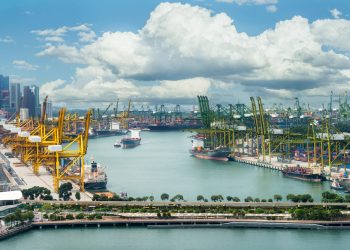Following a recent maritime incident at the Singapore Terminal on 14 June 2024, involving the dredger VOX MARINER and bunker vessel MARINE HONOUR, significant efforts are underway to mitigate the environmental impact caused by the rupture of an oil cargo tank onboard the MARINE HONOUR.
The allision caused a rupture of one of the MARINE HONOUR’s oil cargo tanks, and its contents of low-sulphur fuel oil were released to the sea. MPA patrol craft were immediately activated and deployed to spray dispersants on the spill. MPA’s oil spill response contractor was also activated, and they mobilised an oil skimmer to reduce the impact of the spill. Booms were also laid around the vessels thereafter as added precaution in case of further leaks from the vessel. Due to the tidal currents, parts of the oil spillage have landed along the southern shorelines including Sentosa, Labrador Nature Reserve, Southern Islands, Marina South Pier, and East Coast Park.
As at 16 June 2024 at 1:30 pm, there are no signs of oil slick within Sisters’ Islands Marine Park but oil sheen was observed in the surrounding waters. To facilitate clean-up efforts, the following beaches will be closed until further notice:
- Beaches at East Coast Park (from Area B to H)
- Labrador Nature Reserve (Jetty and Rocky Shore)
- Sentosa – Sentosa’s beaches remain open for public, but sea activities and swimming are not allowed at Tanjong, Palawan and Siloso Beach
- Beaches at St John’s, Lazarus, and Kusu Islands
The public is advised to keep away from these areas to facilitate the clean-up operations. All other areas at both East Coast Park and Labrador Nature Reserve including F&B remain open. National Parks Board (NParks) has also deployed oil absorbent booms to protect Berlayer Creek and the Rocky Shore at Labrador Nature Reserve. While West Coast Park is not affected, oil absorbent booms have also been deployed at West Coast Park to protect the mangroves at the Marsh Garden. Close to 1500 metres of containment booms have been progressively deployed since last Friday, at various locations including the three beaches at Sentosa, entrance of Keppel Marina, off Labrador Nature Reserve, East Coast Park and West Coast Park.
Another 1600 metres of booms will be laid over the next few days to prevent further spread of oil onto the shore. The booms are less effective when there are higher waves above 0.5 metres. Use of dispersants can help to break down the surface oil into droplets to enhance biodegradation. For treated oil with dispersants, these may be suspended in the water and be carried by tidal currents to coastlines.
Oil recovery efforts at sea are progressing. Oil Spill Response Limited (OSRL), the largest international industry-funded cooperative providing oil spill response services, is supporting the clean-up efforts. OSRL will deploy two Current Buster systems, which are floating containment and recovery devices deployed from a vessel. It consists of a boom with a skirt that extends below the water surface to corral and concentrate the oil on the water surface. OSRL’s capabilities will be in addition to two skimmer craft deployed. The skimmer craft is a specialised vessel equipped with skimming equipment to skim and “lift” the oil off the water surface into storage tanks.






























































